Clay meditation techniques offer a powerful way to sculpt your stress away. You'll engage your senses and quiet your mind as you mold and shape clay, combining tactile therapy with mindfulness. This practice doesn't require artistic skill—it's all about the process, not the end product. As you work the clay, you'll ground yourself in the present moment, transforming abstract emotions into tangible forms. The repetitive motions and focus on texture can calm your nervous system and improve concentration. By setting up a peaceful space and exploring various techniques, you'll discover a unique path to relaxation and self-expression. Dive deeper to uncover the full potential of this creative stress-relief method.
Understanding Clay Meditation

Clay meditation is a mindful practice that combines the tactile experience of working with clay and the calming effects of meditation. As you engage with this unique form of mindfulness, you'll find yourself focusing on the present moment, letting go of external worries, and connecting with your inner self.
Unlike traditional meditation, clay meditation engages your sense of touch, providing a tangible anchor for your thoughts. You'll feel the cool, smooth texture of the clay in your hands, allowing you to ground yourself in the physical world while exploring your mental landscape.
This practice doesn't require artistic skill or experience with pottery. Instead, it's about the process of manipulating the clay, not the end product. As you knead, roll, and shape the clay, you'll find your mind naturally settling into a meditative state.
Clay meditation can help reduce stress, improve focus, and boost creativity. It's particularly beneficial for those who struggle with sitting still during traditional meditation. By giving your hands something to do, you're able to quiet your mind more easily.
Benefits of Sculpting for Anxiety
As you explore clay meditation, you'll discover its powerful benefits for anxiety relief.
Through tactile stress relief and mindful artistic expression, you're able to channel your worries into a creative outlet.
You'll also find your focus skills improving as you concentrate on shaping and molding the clay, helping to quiet anxious thoughts.
Tactile Stress Relief
The therapeutic power of touch comes alive through clay sculpting, offering a unique form of stress relief. As you engage with the clay, your hands become instruments of relaxation, kneading away tension and anxiety. The tactile experience grounds you in the present moment, activating your senses and diverting your mind from stressors.
Clay's malleability allows you to physically manipulate your emotions, transforming abstract feelings into tangible forms. This process can help you externalize and process difficult emotions, providing a non-verbal outlet for expression. The repetitive motions of sculpting also induce a meditative state, calming your nervous system and reducing stress hormones.
Here's a breakdown of clay's tactile benefits:
| Sensory Aspect | Stress Relief Benefit |
|---|---|
| Texture | Grounding, focus |
| Temperature | Comfort, awareness |
| Malleability | Emotional expression |
| Pressure | Tension release |
Mindful Artistic Expression
When you engage in clay sculpting as a form of mindful artistic expression, you're tapping into a powerful tool for managing anxiety. This creative process allows you to focus your energy on shaping and molding the clay, redirecting your thoughts away from worries and stressors. As you work, you'll find yourself becoming more present in the moment, fully absorbed in the tactile sensations and artistic decisions.
Clay sculpting encourages self-expression without the pressure of perfection. You're free to explore your emotions and ideas through the medium, creating forms that represent your inner experiences. This non-verbal outlet can be especially beneficial when you're struggling to articulate your feelings verbally.
The act of transforming a shapeless lump of clay into a meaningful form can also boost your sense of accomplishment and self-esteem. You'll develop patience and persistence as you work through challenges in your sculpting process, skills that can transfer to other areas of your life.
Additionally, the finished piece serves as a tangible reminder of your ability to create and overcome obstacles, reinforcing positive self-perception and reducing anxiety.
Improved Focus Skills
Beyond artistic expression, clay sculpting offers significant benefits for improving focus skills, which can be instrumental in managing anxiety. As you engage with the clay, you'll find your attention naturally drawn to the present moment, quieting the anxious thoughts that often plague your mind. This heightened focus can spill over into other areas of your life, helping you stay centered during stressful situations.
When you're sculpting, you're forced to concentrate on the tactile sensations and the intricate details of your creation. This level of attention trains your brain to filter out distractions and maintain focus for extended periods. You'll likely notice improvements in your ability to concentrate on tasks at work or in your personal life.
Moreover, the repetitive nature of certain sculpting techniques, such as kneading or smoothing clay, can induce a meditative state. This rhythmic focus can help calm your nervous system and reduce anxiety symptoms.
Choosing Your Clay or Playdough

Selecting the right clay or playdough is essential for your meditation practice. Consider factors like texture, pliability, and drying time when making your choice. Natural clay offers a more authentic experience, connecting you to the earth, while playdough provides a quick, no-mess alternative.
For beginners, a soft, easily moldable material is ideal, allowing you to focus on the sensations without struggling with manipulation. If you're environmentally conscious, opt for eco-friendly options made from natural ingredients. These can include homemade playdough using flour, salt, and water, or organic clay sourced from sustainable suppliers.
Remember that your chosen material should feel comfortable in your hands and not cause any irritation or allergic reactions.
Here's what to keep in mind when selecting your clay or playdough:
- Texture: Smooth for relaxation, grainy for grounding
- Scent: Unscented for focus, lightly scented for aromatherapy benefits
- Color: Neutral tones for calmness, vibrant hues for creativity
- Consistency: Firm for strength-building, soft for stress relief
Experiment with different types to find what works best for you. Your chosen material should enhance your meditation experience, allowing you to fully immerse yourself in the practice of mindful creation.
Setting Up Your Meditation Space
With your clay or playdough in hand, it's time to create an environment that supports your meditation practice. Choose a quiet, comfortable space where you won't be disturbed.
Make certain you have a clean, flat surface to work on, such as a table or a lap desk. Spread a cloth or mat to protect the area and make cleanup easier.
Set up proper lighting; natural light is ideal, but soft artificial light works too. Consider using a small lamp to illuminate your workspace without harsh glare.
Position yourself comfortably, either sitting on a cushion on the floor or in a chair with good back support.
Keep a small bowl of water nearby to moisten your clay if needed. Have a few simple tools on hand, like a plastic knife or wooden stick, for adding texture or details to your creations.
You might also want to include calming elements in your space, such as plants, candles, or soothing music.
Basic Clay Manipulation Techniques

Mastering basic clay manipulation techniques forms the foundation of your clay meditation practice.
Begin by kneading the clay to warm it up and improve its plasticity. This process also helps you connect with the material and start focusing your mind.
Next, practice rolling the clay into balls of various sizes, feeling the texture and weight in your hands. As you become more comfortable, try creating simple shapes like cubes, cylinders, and cones.
Pinching and coiling are two essential techniques you'll want to explore. Pinching involves using your thumb and fingers to shape the clay, while coiling requires rolling out thin strips and stacking them to build forms.
As you work, pay attention to your breath and the sensations in your hands.
Here are some key benefits of mastering these techniques:
- Improves hand-eye coordination
- Enhances focus and concentration
- Develops patience and mindfulness
- Boosts creativity and self-expression
Breathing Exercises While Sculpting
Breathing exercises go hand in hand with clay sculpting, enhancing your meditative experience. As you work with the clay, focus on your breath to deepen your concentration and relax your body. Start with deep belly breaths, inhaling for four counts and exhaling for six. This rhythmic breathing will help you stay present and mindful as you mold the clay.
Try synchronizing your breath with your sculpting movements. Inhale as you gather clay, exhale as you shape it. This coordination creates a harmonious flow between your body and the material. For more advanced practice, incorporate alternate nostril breathing. This technique balances your energy and calms your mind while you work.
| Breathing Technique | Benefits | When to Use |
|---|---|---|
| Deep Belly Breaths | Relaxation, Focus | Throughout session |
| Breath Syncing | Flow, Mindfulness | During shaping |
| Alternate Nostril | Balance, Calmness | Before intricate work |
Mindful Clay Rolling and Shaping

How can you transform a simple act of clay manipulation into a profound meditative experience? As you begin to roll and shape your clay, focus on each movement with deliberate intention.
Feel the texture beneath your fingertips, noting the coolness or warmth of the material. Pay attention to the pressure you're applying and how the clay responds to your touch.
As you work, maintain awareness of your breath, allowing it to flow naturally. Notice any thoughts that arise without judgment, then gently return your focus to the clay.
Experiment with different techniques—pinching, coiling, or smoothing—and observe how each method affects your state of mind.
Consider the following aspects while practicing mindful clay shaping:
- The impermanence of your creation
- The connection between your hands and the earth
- The parallel between molding clay and shaping your thoughts
- The balance between control and surrender in the creative process
Creating Symbolic Stress Containers
With your hands deep in clay, you can begin crafting symbolic stress containers as a powerful meditation technique. These containers serve as physical representations of your mental and emotional burdens, allowing you to externalize and process your stress.
Start by visualizing your stressors as tangible objects. As you mold the clay, imagine you're shaping a vessel that can hold these worries. Create a container that feels right to you—it could be a simple bowl, a jar with a lid, or even an abstract form. Focus on the texture and temperature of the clay as you work, staying present in the moment.
Once you've formed your container, take time to decorate or add details that represent specific stressors. You might carve words, press in textures, or attach small clay symbols. As you embellish your creation, mentally place each worry into the container. This act of transferring your stress to the clay object can be incredibly cathartic.
After you've finished, you can choose to keep your stress container as a reminder of your ability to manage stress, or ritualistically destroy it to symbolize letting go.
Texture Exploration for Relaxation

Engage your senses through touch as you explore various clay textures, allowing your fingertips to become fully aware of each unique surface.
You'll find relaxation in mindfully manipulating the clay, creating patterns and impressions that reflect your inner state.
Sensory Focus Through Touch
Texture exploration forms a cornerstone of clay meditation, offering a powerful way to anchor your mind in the present moment. As you engage with the clay, focus intently on the sensations in your fingertips. Notice the cool, damp feel of the material and how it warms as you work it. Pay attention to the clay's resistance as you knead, press, and shape it.
This sensory focus through touch helps quiet your mind's chatter, allowing you to fully immerse yourself in the experience. You'll find that concentrating on these tactile sensations can effectively reduce stress and anxiety. As you continue to manipulate the clay, let your awareness expand to include the changing textures you create.
Here are some ways to enhance your sensory focus:
- Close your eyes to heighten your sense of touch
- Experiment with different clay consistencies
- Use various tools to create diverse textures
- Alternate between using your fingers and your palms
Mindful Texture Manipulation
Building upon the sensory focus techniques, mindful texture manipulation takes your clay meditation practice to a deeper level of relaxation. As you work with the clay, pay close attention to its texture and how it changes under your touch.
Start by gently kneading the clay, noticing its plasticity and resistance. Feel how it becomes more pliable as you work it.
Experiment with different textures by pressing objects into the clay or using tools to create patterns. Run your fingers over these impressions, focusing on the sensations they produce.
Try smoothing out rough areas or adding more texture to smooth surfaces. As you manipulate the clay, observe how its temperature changes with your body heat.
Concentrate on the way the clay responds to your movements. Notice how it stretches, compresses, or crumbles depending on your actions.
This mindful exploration of texture helps ground you in the present moment, diverting your attention from stressful thoughts. By fully engaging with the clay's tactile qualities, you'll deepen your meditative state and enhance your overall relaxation experience.
Grounding With Clay Surfaces
The earth beneath your fingers becomes a gateway to tranquility in this grounding technique. As you explore clay surfaces, you'll connect with the present moment and release tension.
Start by choosing a smooth, flat clay surface. Place your palms on the cool material, feeling its texture and temperature. Slowly move your hands across the surface, noticing every ridge, bump, and groove.
Focus on the sensations in your fingertips as you trace patterns or press gently into the clay. This tactile experience anchors you to the here and now, drawing your attention away from racing thoughts. As you continue, you may find your breath naturally slowing and your muscles relaxing.
Experiment with different clay textures and temperatures to deepen your practice:
- Rough, grainy surfaces for heightened sensory awareness
- Warm clay to soothe and comfort
- Cool clay to invigorate and refresh
- Damp clay for a unique, earthy connection
Color Therapy in Clay Meditation
Color therapy adds a vibrant dimension to clay meditation, enhancing its therapeutic benefits. As you work with clay, you'll find that different colors can evoke various emotions and states of mind.
Choose your clay colors intentionally to align with your meditation goals. Warm tones like red, orange, and yellow can energize and stimulate creativity, while cool hues such as blue, green, and purple promote relaxation and introspection.
You can incorporate color therapy by selecting pre-colored clay or adding pigments to natural clay. As you mold and shape the material, focus on the color's energy and how it influences your mood.
For a balanced meditation session, try combining complementary colors or creating a gradient effect. You might also experiment with layering different colored clays to represent various aspects of your life or emotions.
Don't limit yourself to just the clay's color; consider your surroundings too. Use colored lighting or place your meditation space near colorful objects to enhance the overall experience.
Guided Imagery With Clay Forms

As you shape clay with your hands, imagine peaceful landscapes forming beneath your fingertips.
Transform your emotions into tangible forms, allowing the clay to embody your feelings.
Explore the clay's texture mindfully, noticing how different pressures and movements create varied sensations and visual effects.
Visualizing Peaceful Clay Landscapes
Once you've settled into a comfortable position with your clay, close your eyes and begin to imagine a serene landscape crafted entirely from clay. Picture a gentle clay river winding through rolling hills, with delicate clay trees lining its banks. Envision clay mountains in the distance, their peaks dusted with white clay snow.
As you explore this peaceful scene in your mind, focus on the textures and colors of the clay elements.
Now, use your hands to recreate parts of this landscape with the clay before you. Let your fingers shape the contours of hills or form the trunk of a tree. As you work, maintain your connection to the tranquil mental image you've created. This process combines the calming effects of visualization with the tactile benefits of working with clay.
Consider the deeper meanings behind this exercise:
- Sculpting your inner world into tangible forms
- Bringing imagination to life through creative expression
- Connecting mind and body through sensory engagement
- Transforming mental imagery into physical reality
Shaping Emotions Into Forms
While working with clay, you can explore a powerful meditation technique that involves shaping your emotions into physical forms. This practice allows you to externalize and process your feelings in a tangible way.
Begin by centering yourself and focusing on a specific emotion you're experiencing. As you connect with this feeling, let your hands mold the clay intuitively. Don't overthink the process; allow your subconscious to guide your movements. You might create abstract shapes, recognizable objects, or a combination of both.
As you shape the clay, observe how your emotion transforms. You may notice the intensity changing or new insights emerging. If you're working with a challenging emotion, try reshaping the clay into a more positive form. This physical act can help shift your mental state.
Once you've finished, take time to reflect on your creation. What does it reveal about your emotional state? How has the process affected your feelings?
You can choose to keep your clay form as a reminder or reshape it for future sessions. This technique offers a unique way to understand and manage your emotions through tactile expression.
Mindful Clay Texture Exploration
Texture exploration offers another dimension to clay meditation, combining mindfulness with sensory experience. As you work with the clay, focus on the various textures you can create and feel. Run your fingers over smooth surfaces, press patterns into the clay, or create rough, uneven areas.
Pay attention to how each texture feels against your skin and how it changes as you manipulate the clay. Experiment with different tools to create unique textures. Use a fork to make parallel lines, a sponge for a porous effect, or even natural objects like leaves or bark for interesting impressions.
As you explore, remain present in the moment, observing your thoughts and feelings without judgment. This practice can help you:
- Develop a deeper connection with your sense of touch
- Improve focus and concentration
- Release tension and stress through tactile engagement
- Cultivate creativity and self-expression
Release Tension Through Destruction
Letting go of stress through destruction can be a powerful clay meditation technique. As you work with clay, you'll find that breaking it down can be just as therapeutic as building it up.
Start by forming a large, solid shape with your clay. This could be a sphere, cube, or any form that feels substantial in your hands.
Once you've created your shape, focus on your breath and any tension you're holding in your body. Now, begin to slowly destroy the clay form. You can smash it with your fist, tear it apart with your fingers, or use tools to cut and slice through it.
As you demolish the clay, visualize your stress and negative emotions being released with each destructive action.
Pay attention to the sensations in your hands and arms as you break down the clay. Notice the changing textures and the satisfaction of dismantling what you've created.
After you've fully destroyed your clay form, take a moment to reflect on the experience. You may find that this process of creation and destruction mirrors the natural cycles of life and helps you let go of pent-up emotions.
Incorporating Affirmations Into Sculptures
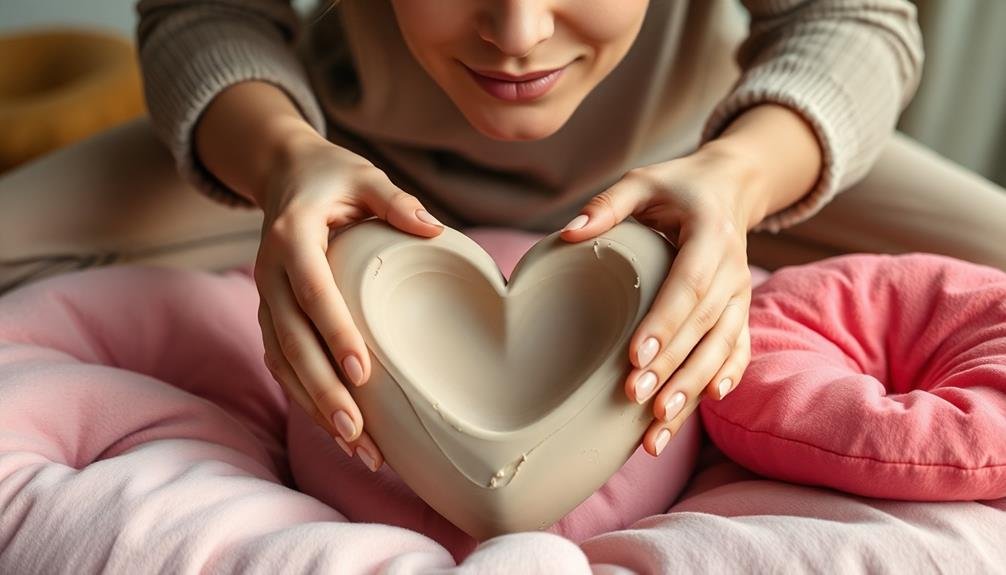
Infuse your clay sculptures with positive energy by incorporating affirmations into your creative process. As you mold and shape the clay, repeat meaningful phrases that resonate with your goals and aspirations. This practice not only enhances your meditation but also imbues your artwork with intention and purpose.
Choose affirmations that align with your personal growth objectives or the emotions you want to cultivate. As you work, visualize these positive statements taking form in the clay. You can even carve or imprint words directly onto your sculpture, creating a physical representation of your affirmations.
Consider these ideas to deepen your practice:
- Whisper your affirmations as you work, allowing the vibrations to penetrate the clay
- Create a series of small sculptures, each representing a different affirmation
- Use colors that correspond to the emotions or qualities you're affirming
- Display your finished pieces as reminders of your intentions
Frequently Asked Questions
Can Clay Meditation Be Effective for Children With Anxiety Disorders?
Yes, clay meditation can be effective for children with anxiety disorders. You'll find it helps them focus, express emotions, and relax. It's a tactile, creative outlet that can reduce stress and improve mindfulness in kids.
Are There Any Potential Allergic Reactions to Consider When Using Clay?
You should be aware of potential allergic reactions to clay. Some people may experience skin irritation or respiratory issues. It's best to use hypoallergenic clay and test a small area first. If you're concerned, consult a doctor.
How Long Should a Typical Clay Meditation Session Last?
You'll find that a typical clay meditation session can last anywhere from 15 to 60 minutes. Start with shorter sessions and gradually increase as you become more comfortable. Listen to your body and stop when you feel relaxed and centered.
Can Clay Meditation Be Practiced in Group Therapy Settings?
Yes, you can practice clay meditation in group therapy settings. It's an excellent way to foster connection and shared experiences. You'll benefit from the collective energy and support while working with clay to reduce stress and enhance mindfulness.
Are There Advanced Techniques for Experienced Clay Meditators to Explore?
Yes, you can explore advanced clay meditation techniques. Try incorporating mindful breathing exercises, creating more complex forms, or using different clay types. You'll also benefit from experimenting with guided visualizations and integrating symbolic meanings into your creations.
In Summary
You've now discovered the power of clay meditation to sculpt away your stress. By engaging your senses and focusing your mind, you're creating a unique path to inner peace. Don't be afraid to experiment with different techniques and materials. Remember, there's no right or wrong way to practice. Whether you're molding, squeezing, or destroying, you're releasing tension with every touch. Embrace this tactile form of mindfulness and watch your worries melt away like soft clay.
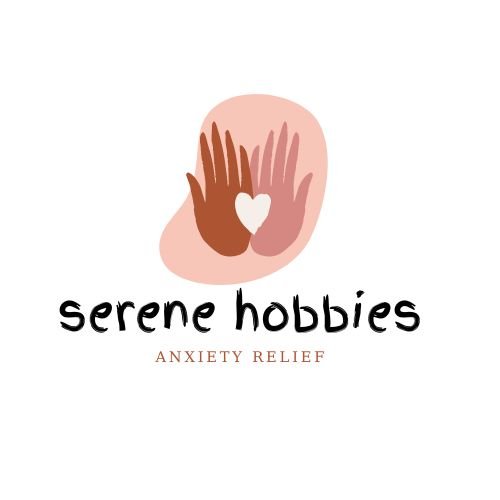
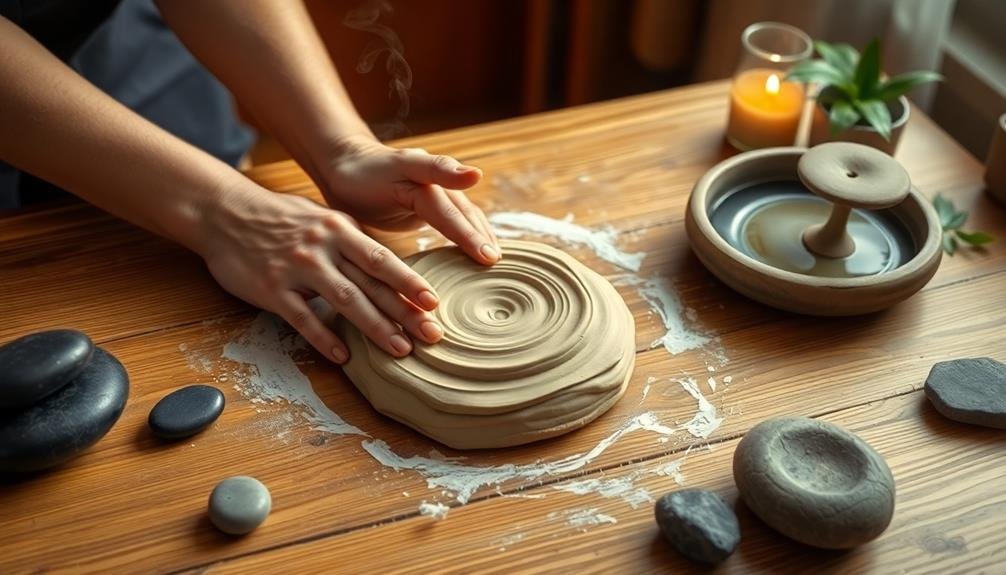

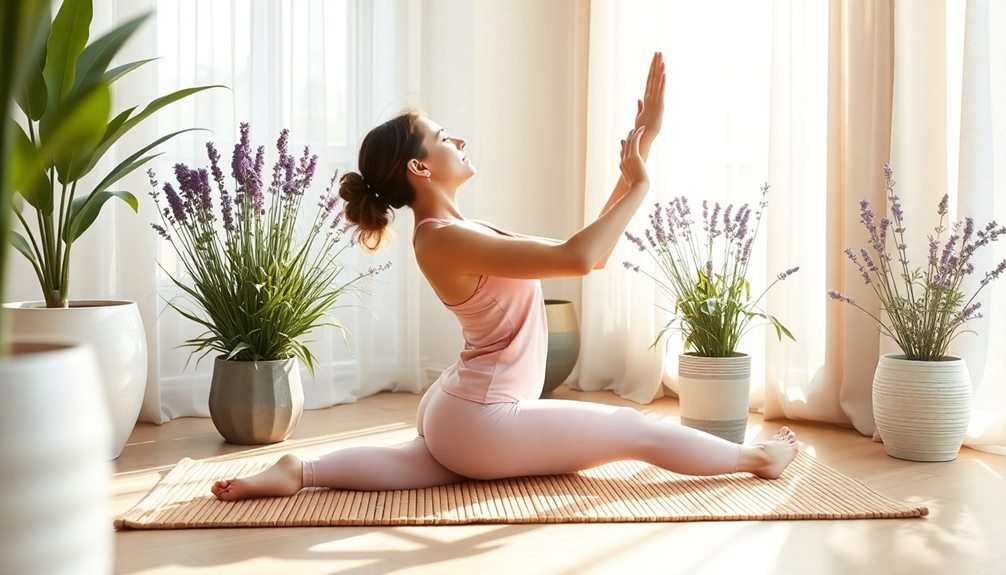
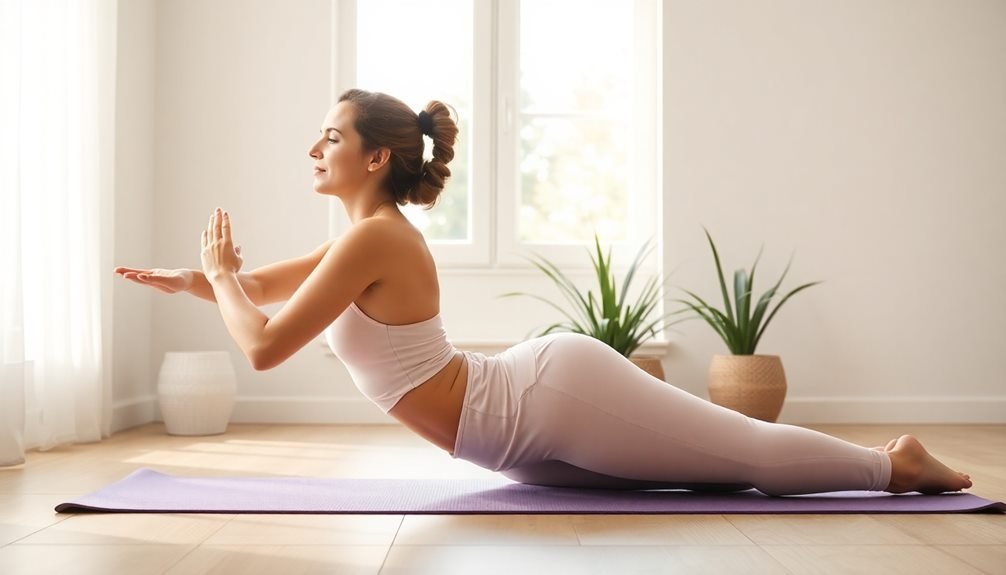
Leave a Reply